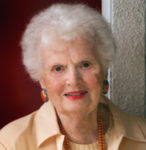By Natasha Josefowitz, ACSW, Ph.D.

LA JOLLA, California — “Your eye pressure is fifty,” says Dr. Robert Weinreb, Director of the Shiley Eye Institute and my ophthalmologist, whose expertise is glaucoma. “We have been unable to control your eye pressure with drops; I am recommending eye surgery.”
I, of course, am immediately reluctant and ask, “What happens if we don’t operate?”
“You may lose the sight of your eye or have a blocked blood vessel in the eye—something like a stroke,” is his response. “There really is no choice.”
At that glum prediction, I acquiesce. “When I ask?
“Today is Friday,” he replies. “We’ll do it Monday.”
I also have macular degeneration and receive regular shots in that eye from Dr. Eric Nudleman; that disease has been improving. “What are you going to do?” I ask with anxiety rising as the inevitability of the looming operation becomes reality.
Dr. Weinreb explains that it is one of several new procedures classified as Minimally Invasive Glaucoma Surgery (MIGS). A tiny gel implant is placed inside the outer part of the eye. The implant is actually a tiny tube with an inner diameter of forty-five microns, that allows the fluid in the eye to drain slowly and lower the eye pressure. It is called MIGS as there is minimal tissue disruption, short surgical time, simple instrumentation, and fast post-operative recovery. This procedure should take about fifteen minutes. I have to stay in the recovery room on the third floor for a while in order for the anesthetic to wear off.
“Oh my goodness,” I say. I had read that for people my age, anesthesia can impact cognition. I am reassured that it won’t be general, just enough to relax me. I will not be allowed to bend down or lift heavy objects for two weeks following the surgery, so I have two days to arrange my apartment. I have restless nights.
Monday does eventually come. Sheri, one of our White Sands drivers, takes me at 8:15 in the morning. Upon arrival, after registering, I am taken to a pre-op room to change into the proverbial hospital gown which ties in the back. I lie down on a gurney with an IV, a blood pressure monitor (that inflates itself every few minutes throughout the operation), and a pulse oximeter on my finger.
Dr. Mark Schwartz, the anesthesiologist, comes over. I tell him of my concern about the pending loss of brain cells from the anesthesia for people my age (I am 94). He agrees to give me very little Versed, the usual culprit, and some Fentanyl. After just a couple of minutes of conversation, Dr. Schwartz says: “Don’t micro-manage during the operation.” How did he get my number so quickly?
Dr. Weinreb comes over to reassure me and tells me everything is ready. I am wheeled into the operating room and a sheet is placed over my face with an opening over my eye. After some numbing eye drops, I feel no pain during the operation, only some pressure over the eye. I know how to relax from my meditation class. Before I know it, Dr. Weinreb says that the operation is over. He is pleased; the procedure was successful. The entire staff was impressed as he performed it in a mere four minutes.
I rest on my gurney for half an hour, and I’m off in a wheelchair to the waiting car. Sheri had already called ahead to White Sands so that upon my arrival a wheelchair was waiting to take me to my room. My wonderful caregiver, Melissa, puts a drop in my eye; thereafter, I could do the drops on my own—every two hours while I’m awake. I sleep well; I am surprised that I have no aftereffects from the anesthesia. My eye is barely sore.
The next morning I return to the hospital for a post-op follow-up appointment. While Dr. Weinreb examines me, he invites a resident and two fellows to come and take a look at the results of a successful operation. (The institute is a teaching hospital.) My eye pressure went from fifty to nine.
MIGS, the type of surgery performed by Dr. Weinreb, has been available for only a few years and is replacing much riskier procedures for many patients with glaucoma. I feel fortunate to be able benefit from this miracle of modern surgery and very grateful to Dr. Weinreb, Dr Nudleman, and their entire team at the Shiley Eye Institute. I am now free of the fear of losing my sight.
© Natasha Josefowitz. This article appeared initially in the La Jolla Village News. You may comment to natasha.josefowitz@sdjewishworld.com